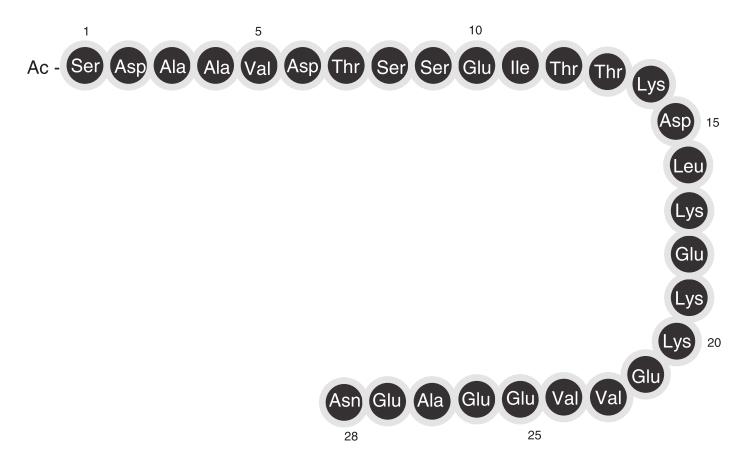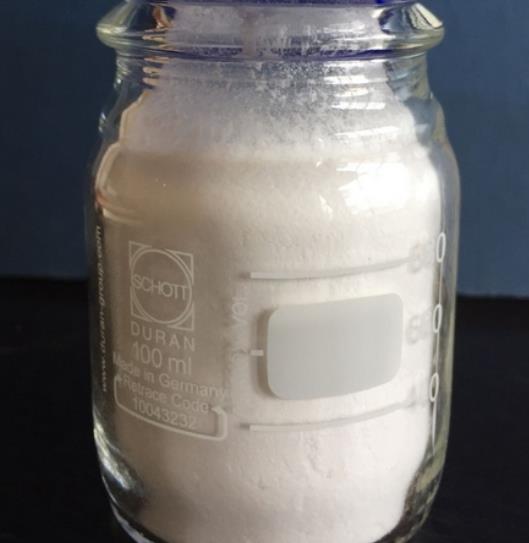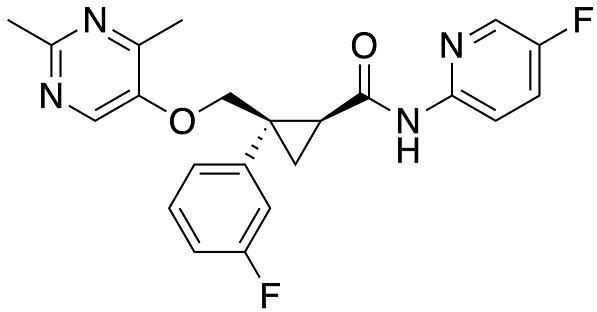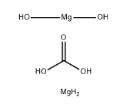Thymalfasin: Bioactivity And Mechanism of Action Studies
General description
The Thymalfasin, with the CAS No: 69440-99-9, is a 28-amino acid peptide, the N-terminus of a larger peptide, prothymosin, with no tertiary structure and no other post-translational modifications except an N-terminal acetylation. Although originally isolated from he thymus gland in mammals by Goldestein in 1977, thymalfasin (ZADAXIN®) is now produced synthetically by solid phase peptide synthesis. This chemical’s molecular formula is C129H215N33O55 and molecular weight is 3108.275. Thymalfasin (thymosin-alpha 1) is an immunomodulating agent able to enhance the Th1 immune response. It has been evaluated for its immunomodulatory activities and related therapeutic potential in several diseases, including chronic hepatitis B and C, AIDS, primary immunodeficiency diseases, depressed response to vaccination and cancer. The basis for effectiveness in these conditions is primarily through modulation of immunological responsiveness, as thymalfasin has been shown to have beneficial effects on numerous immune system parameters and to increase T-cell differentiation and maturation. Thymalfasin is responsible for reconstitution of immune function when thymic tissue is given back to thymectomized animals. Thymalfasin has been shown to have efficacy in multiple experimental models of immune dysfunction, mainly, infectious diseases.[1] Numerous experiments have confirmed the anti-proliferative activity of thymalfasin against melanoma, lung cancer breast cancer, and glioblastoma. Furthermore, thymalfasin activity has been evaluated in a phase II trial of patients with metastatic melanoma. [2]
Figure 1 Primary structure of thymalfasin.
Preparation
By combining traditional solid-liquid-phase synthesizing and coupling techniques with peptide synthesis methods to obtain the synthetic process with high product quality and low cost that is suitable for industrial production, and to investigate the stability of its preparations. The sequence of thymalfasin was divided into three parts, three full-protected peptides were obtained by solid-phase synthesis, and the fragments were coupled in the liquid phase to obtain thymalfasin. The thymalfasin preparation was produced and its stability was studied according to the original prescription. The purity of thymalfasin obtained through synthesis was 99.85%, The stability of the preparation is good. Under the accelerated conditions, it is consistent with the trend of the original research product. Through this synthesis process, it is able to obtained thymalfasin with high purity, small single impurities, and high yield, low cost of single-gram materials. Besides, the production period is short, and easy to scale-up. Thus to provides high-quality, low-cost API for the production of the thymalfasin for injection.[3]
Pharmacodynamics
Thymalfasin, when added to bone marrow stem cells cultured with thymic epithelial fragments, not only increases CD4 + cells, but also significantly increases the amount of interleukin-7 (IL-7) produced, a stimulus for thymopoesis.[4] In rat colorectal cancer, thymalfasin plus IL-2 has been shown to reverse chemotherapysuppressed CD4 counts.[5] Thymalfasin enhances the production of CD3, CD4 and CD8 cells in patients with chronic hepatitis B and cancer, in mice infected with influenza A virus, and in mice immunosuppressed by hydrocortisone treatment.[6] Thymalfasin has also been shown to increase the activity of natural killer (NK) cells in multiple animal models, normal human subjects, and in patients infected with HIV. This effect may be important for combating viral infections, such as hepatitis C, where NK activity is decreased.[7]
Thymalfasin increases production of interferon-g, IL-2, IL-3 and the expression of the IL-2 receptor following activation by mitogens or antigens. A Th1-type immune response is associated with a vigorous antiviral response, while a Th2 response is associated with persistence of viral infection and may be a viral mechanism for avoiding immune surveillance. Thymalfasin has been demonstrated to increase the Th1 subset of helper T-cells and IL-2 production in peripheral blood mononuclear cells from hepatitis C virus-positive patients. When combined with interferon-a, thymalfasin significantly increases IL-2 levels over those seen with interferon-a alone, and decreases the Th2 cytokines, IL-4 and IL-10, associated with interferon-a.[8] Thus, thymalfasin not only increases Th1 subsets needed for clearance of hepatitis C virus, but also blocks the interferon-a-induced Th2 response. Thymalfasin not only causes precursor stem cells to increase production of T-cells, but it also decreases the removal of T-cells through apoptosis. Thymalfasin antagonizes dexamethasone-induced apoptosis in thymocytes in vitro, and decreases dexamethasone or antiCD3 antibody-induced T-cell apoptosis in tumorbearing mice.[9] The mechanism may be related to observed increases in protein kinase C and cyclic AMP, to the antiapoptotic bcl-2, and also to decreases in the expression of the pro-apoptotic proteins bax, bad and fas. In the rare congenital disorder characterized by the absence or hypoplasia of the thymus resulting in varying degrees of T-cell immunodeficiency (DiGeorge syndrome), thymalfasin treatment is associated with a decrease in lymphocyte apoptosis and the expression of fas ligand and clinical improvement.[10]
Virally infected or cancer cells have decreased expression of major histocompatibility complex (MHC) class 1 so that they are hidden from the immune system. Thymalfasin has been shown to increase the expression of MHC class 1 in cultured cells.[11] Thymalfasin may therefore improve the ability of the immune system to recognize defective cells. The ability of thymalfasin to increase immune recognition of infected cells is different from that of interferon, and involves NFkB. In addition to increasing MHC class 1, NFkB is involved in antiapoptosis, in IL-2 production, and in glutathione’s effects, among many others. The relationship of thymalfasin to NFkB may explain the pleiotropic effect of thymalfasin treatment. Treatment with thymalfasin significantly decreases the level of circulating virus, as determined by measuring serum woodchuck hepatitis B virus DNA, liver DNA (replicative intermediates) and liver DNA (transcripts). However, in this animal model, similar to human hepatitis B virus, the serum and liver virus levels returned to pretreatment levels once treatment ceased, similar to interferon treatment.[12] In a study reproducing this result where the animals were treated for three years, there was a trend towards a decrease in hepatocellular carcinoma with thymalfasin treatment compared to placebo.[13]
Thymalfasin has been shown to decrease replication of duck hepatitis B virus in cultured duck hepatocytes. In duck hepatitis B, thymalfasin exerted its greatest effect on relaxed circular (RC) DNA as well as on viral proteins. Inhibition of viral replication is especially apparent at the post-translational level of expression of intrahepatic viral proteins, further distinguishing thymalfasin’s effects from those of nucleoside analogs and interferon-a, which act at different steps in the viral lifecycle.[14] In addition to these direct antiviral effects, thymalfasin has been reported to inhibit in vitro growth of various non-small cell lung cancer cell lines, and inhibit the growth of neoplastic cells in vivo, preventing lung adenoma formation in mice and breast cancer in rats.[1]
Mechanism of Action
Thymalfasin has been shown to increase the expression of MHC class 1 in cultured cells.[11] Thymalfasin may therefore improve the ability of the immune system to recognize defective cells. The ability of thymalfasin to increase immune recognition of infected cells is different from that of interferon, and involves NFkB. In addition to increasing MHC class 1, NFkB is involved in antiapoptosis, in IL-2 production, and in glutathione’s effects, among many others. The relationship of thymalfasin to NFkB may explain the pleiotropic effect of thymalfasin treatment.[1] Thymalfasin has a number of immunomodulatory activities, as well as direct influences on virally infected or cancerous cells.[15] Although the cellular receptor for thymalfasin has not been identified, data obtained from in vitro studies support its mechanism of action. This proposed mechanism of action is two-fold, showing effects of stimulation of the immunological functions and inhibition of viral replication.[1]
References
[1]Sjogren, M. H. Thymalfasin: an immune system enhancer for the treatment of liver disease[J]. Journal of Gastroenterology and Hepatology, 2004, 19: S69–S72.
[2] Lao X, Meng L, Jiao C, et al. A Tumor-Penetrating Peptide Modification Enhances the Antitumor Activity of Thymosin Alpha 1[J]. Plos One, 2013, 8(8):14102-14109.
[3]Feng F. Study on synthesis and preparation of thymalfasin Abstract [D]. Soochow University.
[4]Knutsen AP, Freeman JJ, Mueller KR, et al. Thymosin-alpha1 stimulates maturation of CD34+ stem cells into CD3+4+ cells in an in vitro thymic epithelia organ coculture model[J]. Int. Immunopharmacol, 1999, 21: 15–26.
[5]Silecchia G, Guarino E, Sinibaldi-Vallebona P, et al. Efficacy of repeated cycles of chemo-immunotherapy with thymosin alpha and interleukin-2 after intraperitoneal 5-fluorouracil delivery[J]. Cancer Immunol. Immunother, 1999, 48: 172–8.
[6]Hadden JW, Saha A, Sosa M, Hadden EM. Immunotherapy with natural interleukins and/or thymosin alpha 1 potently augments T-lymphocyte responses of hydrocortisonetreated aged mice[J]. Int. J. Immunopharmacol, 1995, 17: 821–8.
[7]Kawarabayashi N, Seki S, Hatsuse K, et al. Decrease of CD56 (+) T cells and natural killer cells in cirrhotic livers with hepatitis C may be involved in their susceptibility to hepatocellular carcinoma[J]. Hepatology, 2000, 32: 962–9.
[8]Andreone P, Cursaro C, Gramenzi A, et al. In vitro effect of thymosin-alpha1 and interferon-alpha on Th1 and Th2 cytokine synthesis in patients with chronic hepatitis C.[J]. Journal of Viral Hepatitis, 2001, 8(3):194-201.
[9]Roy R , Singh S M , Shanker A, et al. Mechanism of thymocyte apoptosis induced by serum of tumor-bearing host: the molecular events involved and their inhibition by thymosin alpha-1.[J]. International Journal of Immunopharmacology, 2000, 22(4):309-321.
[10] Gupta S, Aggarwal S, Nguyen T. Accelerated spontaneous programmed cell death in lymphocytes in DiGeorge syndrome[J]. Allergy Clin. Immunol. 1997, 99: S3 (No 11).
[11]Giuliani C, Napolitano G, Mastino A, et al. Thymosin a-1 regulates MHC class I expression in FRTL-5 cells at ranscriptional level[J]. European Journal of Immunology, 2000, 30: 778–6.
[12] Gerin JL, Korba BE, Cote PJ, et al. A preliminary report of a controlled study of thymosin alpha-1 in the woodchuck model of hepadnavirus infection[J]. Adv. Exp. Med. Biol. 1992, 312: 121–3.
[13]Nakamura I, Nupp JT, Cowlen M, et al. Pathogenesis of experimental neonatal woodchuck hepatitis virus infection. Chronicity as an outcome of infection is associated with a diminished acute hepatitis that is temporally deficient for the expression of interferon gamma and tumor necrosis factor-alpha messenger RNAs[J]. Hepatology, 2001, 33: 439–7.
[14] Colledge D, Wang Y, Tuthill C, Locarnini S. Antiviral effects of thymosin alpha 1 versus leukocytic interferon in primary cultures of duck hepatocytes persistently infected with duck HBV in vitro. Paper presented at Second International Conference on Therapies for Viral Hepatitis. Kona Hawaii, 1997.
[15]Rasi G, Pierimarchi P, Sinibaldi-Vallebona P, Colella F, Garaci E. Combination therapy in the treatment of chronic viral hepatitis and atocellularcarcinoma[J]. Int. Immunopharmacol. 2003; 3: 1169–76.
Related articles And Qustion
See also
Lastest Price from Thymalfasin manufacturers

US $1.00/g2025-09-22
- CAS:
- 69440-99-9
- Min. Order:
- 10g
- Purity:
- 99
- Supply Ability:
- 999

US $0.00-0.00/Box2025-06-10
- CAS:
- 69440-99-9
- Min. Order:
- 1Box
- Purity:
- 99.99%
- Supply Ability:
- 10 Boxes




